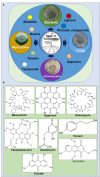Endophytes: A Treasure House of Bioactive Compounds of Medicinal Importance
- PMID: 27746767
- PMCID: PMC5041141
- DOI: 10.3389/fmicb.2016.01538
Endophytes: A Treasure House of Bioactive Compounds of Medicinal Importance
Abstract
Endophytes are an endosymbiotic group of microorganisms that colonize in plants and microbes that can be readily isolated from any microbial or plant growth medium. They act as reservoirs of novel bioactive secondary metabolites, such as alkaloids, phenolic acids, quinones, steroids, saponins, tannins, and terpenoids that serve as a potential candidate for antimicrobial, anti-insect, anticancer and many more properties. While plant sources are being extensively explored for new chemical entities for therapeutic purposes, endophytic microbes also constitute an important source for drug discovery. This review aims to comprehend the contribution and uses of endophytes as an impending source of drugs against various forms of diseases and other possible medicinal use.
Keywords: bioactive compounds; endophytes; foodborne diseases; secondary metabolites.
Figures
References
-
- Abreu-Tarazi M. F., Navarrete A. A., Andreote F. D., Almeida C. V., Tsai S. M., Almeida M. (2010). Endophytic bacteria in long-term in vitro cultivated axenic pineapple microplants revealed by PCR DGGE. World J. Microbiol. Biotechnol. 26 555–560. 10.1007/s11274-009-0191-3 - DOI
-
- Andreote F. D., Gumiere T., Durrer A. (2014). Exploring interactions of plant microbiomes. Sci. Agric. 71 528–539. 10.1590/0103-9016-2014-0195 - DOI
-
- Bacon C. W., White J. F. (2000). Microbial Endophytes. New York, NY: Marcel Dekker Inc.
Publication types
LinkOut - more resources
Full Text Sources
Other Literature Sources


